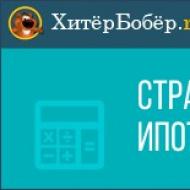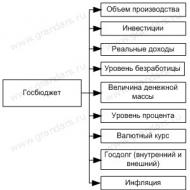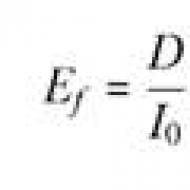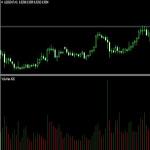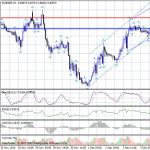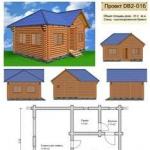
Simplified accounting financial statements how to fill out. Simplified accounting reporting: who hands over
Some enterprises are allowed to use simplified accounting methods by Law No. 402-FZ of 06.12.2011 on accounting and submit appropriate reports. Such companies include small businesses not mentioned in Part 5 of Art. 6 of Law No. 402-FZ, as well as non-profit organizations and firms participating in the Skolkovo project. How simplified reporting is formed, we learn from this article.
Small business accounting statements
The simplified financial statements include two forms approved by order of the Ministry of Finance of the Russian Federation No. 66n:
- balance;
- Report on financial results(OFR).
By analogy with traditional financial reporting, these forms are made at the end of the reporting year. Balance sheet form No. 0710001 includes the provision of summary information for the reporting year, as well as for the past and the year before. Despite the simplified version, the balance sheet contains all the necessary information about assets and their sources. The simplified balance is arranged like the usual form, contains the same indicators as the general one. The only difference can be considered as a more integrated reflection of information, i.e. each line has the highest specific weight.
The balance sheet of a small enterprise with a breakdown of the lines, and the OFR (form No. 0710002) reflect data on the company's income and expenses, recognized in accounting also for the reporting and previous periods. The basis for filling out these forms is the balance sheet, which contains all the data on account balances at the beginning of the period, account turnover and balances at the end of the period.
Instructions for completing simplified financial statements
Before figuring out how to fill out a simplified balance sheet, let's consider what indicators are involved in the formation of the values of each balance line. The regulatory authorities require the submission of forms with line numbering, so we will fill out the balance using the applicable codes.
|
Line code |
Account balance included |
|
|
Assets |
||
|
04, 08 s / s of investments in fixed assets, 09, 58 |
||
|
58, 60, 62, 68, 69, 71, 71, 73, 75, 76 |
||
|
1600: Total asset of the balance |
sum of lines |
|
|
Passive |
||
|
60,62,68,69,70,71,73,76, 75 s / account of settlements on income payment |
||
|
1700: total balance liabilities |
sum of lines |
|
The values of lines 1600 and 1700 must be the same, that is, the balance between the asset and the liability must be observed. The equivalence of both parts is one of the criteria for the correctness of filling out the form.
Continuing to master the procedure for filling out simplified financial statements in 2017, let us turn to Form 2 - OFR, which has its own peculiarities of preparation - the values of income and expenses from sales are recorded without brackets, other expenses - in brackets. This report also focuses on line numbering:
|
The values |
Line no. |
Account turnover |
|
|
by D / that |
by K / that |
||
|
Revenue (excluding VAT and excise taxes) |
90/3 s / s "VAT" |
90/1 s / account "Sales" |
|
|
Expenses for ordinary activities |
90/2 s / account of cost price, commercial and administrative costs |
||
|
NS. income |
91 s / account VAT |
91 s / account of other income |
|
|
% payable |
The amount of interest paid on loans granted |
||
|
NS. expenses |
Debit. turnover 91 s / account of other expenses - line 2330 |
||
|
If the firm pays: NNP, then puts on the line the amount of page 180 of the 2nd sheet of the NNP declaration; USN "Income", then calculates the difference between the values of lines 133 and 143 of section. 2.1.1 tax declarations under the simplified tax system; UTII, the amount due to be paid |
|||
|
Net income (loss) |
The value is displayed using the formula: P. 2110 - p. 2120 + p. 2340 - p. 2350 - p. 2410 A positive result means a profit (indicated without brackets), a negative result means a loss (in brackets). |
||
Financial statements of small businesses 2017: sample
Let's fill in the reports of a small enterprise LLC "Hyacinth", applying the simplified tax system "Income" for example:
The balance sheet of the company for the year:
Account number
Balance at the beginning of the period
Turnovers
End balance
total
Suppose that the interest paid for the loan provided was 5,000 thousand rubles, there were no other expenses in the enterprise, and the calculated tax under the simplified taxation system was 69,000 thousand rubles.
Let's analyze how to fill in the simplified financial statements for 2017. Observing the principle of equivalence of both parts, we add values to the lines:
Account balance
D / t (01 + 08) - K / t 02
400000 + 157000 – 240000 = 317000
D / t (10 + 41 +44)
18000 + 61000 + 5100 = 84100
D / t (50 + 51 + 52)
42200+ 292600 + 50000 = 384800
D / t (62 + 71 + 76)
111900 + 67000 = 178900
Sum of Asset Lines
317000 + 85000 + 84100 + 384800 + 178900 = 1049800
K / t (80 + 82 + 83 + 84)
500000 + 23000 + 32000 + 202600 = 757600
K / t (60 + 68 + 69+ 70)
9500 + 30000 + 30000 + 57700 = 127200
Sum of liability lines
757600 + 165000 + 127200 = 1049800
The second form of simplified financial statements, a sample of which is presented, is the OFR. The algorithm for filling it out in the table:
Line
What is made up of
In sums
Cr. turnover 90/1 - D. turnover 90/3
300000 – 32000 = 268000
D. turnover 90/2
Cr. turnover 91/1 - D. turnover 91/2
100000 – 18000 = 82000
% on loans
Tax on the simplified tax system
Payment
268000 – 100000 + 82000 – 5000 – 69000 = 176000
This is the procedure for filling out financial statements for small businesses. If necessary or desired, companies fill out other forms, but only these two are mandatory.
Small businesses actively use simplified reporting forms when compiling a balance sheet and a statement of financial results for the past year. It would seem much simpler: in the asset of the simplified balance sheet there are only 5 items, and in the liabilities - 6 items. However, even under these “three pines” there are bumps. In this article, we will talk about them.
Let me remind you that simplified reporting forms were approved by the Order of the Ministry of Finance dated 17.08.2012. No. 113n. First, a couple of words about which assets and liabilities fall into which lines of the simplified balance sheet:
1. Tangible non-current assets: fixed assets, unfinished capital investments (accounts 01, 03 minus 02, accounts 07, 08).
2. Intangible, financial and other non-current assets: intangible assets (account 04 minus 05), long-term financial investments (corresponding sub-account of account 58, sub-account 55/3, possibly 73), unfinished investments in intangible assets, research and development results (corresponding subaccounts of account 08, 04)
3. Stocks: raw materials and supplies, work in progress, finished products, goods (accounts 10, 20, 23, 41, 43, 45, etc.)
4. Cash and cash equivalents: cash in cash and on accounts (accounts 50, 51, 52, 55 except for deposits, 57)
5. Financial and other current assets: short-term financial investments (corresponding sub-account of account 58), VAT (account 19), receivables and other assets (accounts 60, 62, 68, 69, 70, 71, 73, 75, 76).
1. Capital and reserves: authorized capital(count 80), additional and Reserve capital(if any, accounts 83 and 82), retained earnings (uncovered loss, account 84), revaluation of fixed assets ( intangible assets), if one is held in the organization (account 83). This line also reflects own shares purchased from shareholders for cancellation (account 81).
2. Long-term borrowed funds: borrowed funds received by long-term loans and loans (account 67).
3. Others long term duties(score 77, 96)
4. Short-term borrowed funds: borrowed funds received from short-term loans and loans (account 66).
5. Accounts payable: debt to creditors on accounts 70, 71, 68, 69, 76, etc.
6. Others Short-term liabilities(score 96)
For each line of the balance, you must enter the corresponding code in the column. What code to put if several indicators are included in the line, each of which has its own code? In clause 5 of the order of the Ministry of Finance No. 66n "On the forms of financial statements of organizations" it is said that the code that corresponds to the largest specific weight is put.
For example, let LLC "Romashka" include in the line "Intangible, financial and other non-current assets":
- intangible assets - 80 thousand rubles.
- long-term financial investments - 200 thousand rubles.
- results of research and development - 150 thousand rubles.
Total: 430 thousand rubles.
Financial investments have the largest share. They correspond to the code 1170. It is he who will be put down in the simplified balance sheet in the line "Intangible, financial and other non-current assets" with the amount of 430 thousand rubles.
The question is - what to do if there is nothing to write to some line? Those. there are no assets or liabilities corresponding to the line. In this case, the string is simply omitted.
A common situation is that the company has only recently been established, no activity has been carried out yet. The usual question is: how to create a zero (empty) balance?
Despite the lack of activity, the balance will not be completely empty. Not only the header will be filled in, but also some lines of liabilities and, possibly, assets.
If the organization is created, then, at least, it has formed the authorized capital:
Debit 75/1 - Credit 80
If the founders have not yet contributed the authorized capital in the form of property (money, goods, fixed assets, etc.), then there is a debt of the founders, which is receivable.
Most often, founders contribute their capital in the form Money to the current account:
Debit 51 - Credit 75/1
As a result, the following lines will be filled in the balance sheet:
Capital and reserves (account balance 80)
Cash and cash equivalents (account balance 51).
Usually, even in the absence of activity, the bank debits funds from the current account for banking service... As a result, the funds on the account "melt", and the balance asset tends to zero.
In this case, the organization has an uncovered loss at the end of the year, the negative value of which “eats up” the authorized capital and the liability becomes zero.
In this case, it is better to use the general form of the balance sheet to show the share capital and uncovered loss in brackets in separate lines of the liability. Or provide an explanation of the balance sheet.
If you do not have time to prepare yourself " zero reporting"And wasting time on trips to tax office then ask for help here:
Another common situation for young organizations is that uncovered losses exceed the amount of the authorized capital, due to which the Capital and reserves line becomes negative.
Let OOO Nezabudka have an authorized capital of 10 thousand rubles, an uncovered loss of 30 thousand rubles. Then, when filling out the simplified balance sheet in the Capital and reserves line, it will show the value (20) and the line code 1300.
A situation close to this begins with the words: we are trying to draw up a balance sheet, the asset turns out to be less than a liability. This, in principle, cannot be. Options: something was not reflected in the asset, or more likely - there are uncovered losses in excess of the authorized capital.
An example of a simplified balance sheet
LLC "Romashka" is a small business entity and fills out the balance sheet according to the results of 2014 in a simplified form.
As of December 31, 2014, the company has the following assets:
- purchased goods, reflected on account 41, in the amount of 20,000 rubles. This amount is reflected in the balance sheet item "Inventories";
- funds for current account in the amount of 10,000 rubles. This amount is reflected in line 1250;
- debt of buyers for payment for goods (ie accounts receivable) in the amount of 15,000 rubles. This data is entered on line 1230.
Total assets (line 1600): 45,000 rubles.
Company liabilities:
- authorized capital - 10,000 rubles, retained earnings - 25,000 rubles. In total, line 1300 reflects 35,000 rubles;
- wage arrears - 3,000 rubles, indebtedness to suppliers - 5,000 rubles, arrears of taxes and fees - 2,000 rubles. Total accounts payable: 10,000 rubles.
The total amount of liabilities on line 1700: 45,000 rubles.
The balance sheet of Romashka LLC is filled in thousands of rubles and looks like this:
SCREENSHOT
The company began operations in February 2014, therefore it does not have data as of 12/31/13 and 12/31/12, therefore, dashes are put in the columns dedicated to previous years.
Problems arising in the preparation of an abbreviated statement of financial results, we discussed in.
Successful submission of reports!
Small businesses can submit reports using simplified forms. They are given in Appendix No. 5 to the Order of the Ministry of Finance of Russia dated July 2, 2010 No. 66n.Criteria for classifying firms as small businesses
An organization can be classified as a small business entity (SME) if it meets all the criteria specified in the table:| P / p No. | Criterion | Limit value | |
|---|---|---|---|
| Microenterprise | Small business | ||
| 1 | The total share of participation in the authorized capital of LLC RF, constituent entities of the RF, municipalities, public, religious organizations, foundations | 25% | |
| 2 | The total share of participation in the authorized capital of other organizations that are not small and medium-sized businesses, as well as foreign organizations | 49% | |
| 3 | Average number of employees for the previous calendar year | 15 people | 100 people |
| 4 | Business income (the amount of revenue and non-operating income) excluding VAT for the previous calendar year | 120 million rubles | 800 million rubles |
In 2016, when entering information into the register of SMEs, the total share of participation in the authorized capital of LLC of other organizations that are not SMEs is not taken into account (Letter of the Federal Tax Service dated 18.08.2016 No. 14-2-04 / [email protected](p. 2)).
For medium-sized businesses, criteria 1 and 2 are set the same as for small and micro-enterprises, while the average number of employees should not exceed 250 people, and income from entrepreneurial activities - 2 billion rubles.
At the same time, such an organization must be entered by the Federal Tax Service in the register of small and medium-sized businesses posted on its official website (part 1, subparagraph "a", paragraph 1, paragraphs 2, 3, part 1.1, part 3 of Art. 4, article 4.1 of the Law No. 209-FZ, paragraph 1 of the Decree of the Government of the Russian Federation of 04.04.2016 No. 265).
Therefore, small businesses can submit financial statements in a simplified manner, namely:
- simplified balance sheet;
- simplified statement of financial results.
- cash flow statement;
- statement of changes in equity;
- explanations ( explanatory note).
The procedure for filling out the balance sheet in a simplified form
You need to start filling out the balance with the heading part, the so-called header. It indicates all the same data as in the usual form: the name of the company, type of activity, organizational and legal form or form of ownership. A simplified balance sheet can also be drawn up in thousands or millions of rubles.In a simplified form balance sheet sections and indicators are significantly less than in the standard form: five indicators in the asset and six in the liability. Their values must be given for three years as of December 31.
Thus, the annual balance sheet contains data on assets and liabilities held by the organization as of December 31 of the reporting year and similar data as of December 31 of the previous and the year before last (p. 10, 18 PBU 4/99, part 1, 6 article 15 of Law 402-FZ).
To fill out the balance lines with the indicators of the reporting year, the organization will need a balance sheet for all accounts for the year.
The line codes that are indicated in the financial statements are given in Appendix No. 4 to the Order of the Ministry of Finance dated 02.07.2010 No. 66n.
However, it does not contain lines with enlarged indicators of simplified balance sheet forms.
The codes of these lines must be determined according to the indicators that have the largest specific weight in the composition of the aggregated indicator.
The first indicator in the asset of the simplified balance sheet is line 1150 "Tangible non-current assets". This line of the balance sheet indicates information on the residual value of fixed assets, as well as data on unfinished assets. capital investments in fixed assets.
In the next line "Intangible, financial and other non-current assets" reflect information on intangible assets, research and development results, exploration assets, profitable investments v material values deferred tax assets and other non-current assets.
This line can combine information from eight lines of a regular balance sheet at once: 1110, 1120, 1130, 1140, 1160, 1170, 1180 and 1190.
Please note: in the enlarged lines of the balance sheet, you must put the code of the indicator that has the largest specific weight in the composition of this indicator (clause 5 of the Order of the Ministry of Finance of Russia dated July 2, 2010 No. 66n).
For example, if on the line "Intangible, financial and other non-current assets" most of the sum of indicators is represented by intangible assets, then you must put the code 1110, if by the results of research and development, then 1120.
How to fill in each of the lines of the simplified balance is written in the section devoted to the regular balance, so here and further we will not re-consider filling in these lines.
The next two lines: "Inventory", "Cash and cash equivalents" and the name and codes of the lines correspond to lines 1210 and 1250 of the standard balance.
Next is the line "Financial and other current assets". It is intended to reflect information about current assets, excluding inventories, cash and cash equivalents. It reflects accounts receivable from buyers, VAT amounts on purchased valuables, cash and short-term financial investments (with a maturity not exceeding 12 months), as well as other current assets of the company.
Depending on the materiality of the indicator, this line can be assigned one of the codes: 1220 “VAT on purchased values”, 1230 “Accounts receivable”, 1240 “Financial investments (excluding cash equivalents)”, 1260 “Other current assets”.
In the last line of the balance sheet asset - 1600 "Balance" - enter the total amount of all items of the balance sheet asset.
The simplified balance sheet liability consists of six lines. In the first line "Capital and reserves" indicate the aggregate data reflected in section. III "Capital and reserves" of the usual form of the balance sheet.
The next two lines reflect information about long-term liabilities. On line 1410 "Long-term borrowed funds" indicate information about loans and borrowings, the maturity of which exceeds 12 months.
Line 1450 “Other long-term liabilities” is intended to reflect all other liabilities that have maturities greater than 12 months.
The next three lines are intended to reflect short-term liabilities (maturity of which does not exceed 12 months).
In line 1510 "Short-term borrowed funds" enter data on loans and borrowings, and in line 1520 - accounts payable. For all other liabilities, line 1550 “Other short-term liabilities” is intended.
In the last line of the balance sheet liability 1700 "Balance" indicate the sum of all items of liability.
For example, here are the commonly used line codes for a simplified balance sheet:
If your company needs to explain some indicators of the balance sheet and the statement of financial results, then they also need to be explained. They need to provide only the most important information, without which it is impossible to evaluate financial condition your company. As the financiers pointed out in the Information "Financial statements of small businesses", it is advisable to indicate in the explanations, for example:
- provisions of the accounting policy that are necessary to explain the procedure for the formation of indicators of the balance sheet and the statement of financial results (what method of accounting for income and expenses the company uses; whether deferred income tax is taken into account along with the current one, facts of a prospective change in accounting policy or prospective restatement when correcting significant errors etc.);
- material facts economic life, which are not disclosed by the indicators of the balance sheet and the statement of financial results. This may be information about significant transactions with owners (founders), such as accruals and payments of dividends, contributions to authorized capital, etc.
It is better to consolidate its decision of the organization in the accounting accounting policies.
Example. Filling in the balance sheet
LLC, registered in 2016, applies a simplified taxation system.
Indicators of registers accounting as of December 31, 2016 are shown in the table.
Balances (Kt - credit, Dt - debit) on the accounts as of December 31, 2016
| Balance | Amount, rub. | Balance | Amount, rub. |
|---|---|---|---|
| Dt 01 | 600 000 | Dt 58 | 150 000 |
| CT 02 | 200 000 | CT 60 | 150 000 |
| Dt 04 | 100 000 | CT 62 (sub-account "Advances") | 500 000 |
| CT 05 | 50 000 | ||
| Dt 10 | 10 000 | CT 69 | 100 000 |
| Dt 19 | 10 000 | CT 70 | 150 000 |
| Dt 43 | 90 000 | CT 80 | 50 000 |
| Dt 50 | 15 000 | CT 82 | 10 000 |
| Dt 51 | 250 000 | CT 84 | 150 000 |
Based on the available data, the accountant compiled the balance sheet for 2016 in a simplified form:
| Indicator name | Code | At 31 December 2016 | At 31 December 2015 | At 31 December 2014 |
|---|---|---|---|---|
| ASSETS | ||||
| Tangible non-current assets | 1150 | 400 | - | - |
| Intangible, financial and other non-current assets | 1170 | 200 | - | - |
| Stocks | 1210 | 100 | - | - |
| Cash and cash equivalents | 1250 | 265 | - | - |
| Financial and other current assets | 1260 | 10 | - | - |
| BALANCE | 1600 | 975 | - | - |
| PASSIVE | ||||
| Capital and reserves | 1370 | 210 | - | - |
| Long-term borrowed funds | 1410 | - | - | - |
| Other long-term liabilities | 1450 | - | - | - |
| Short-term borrowed funds | 1510 | - | - | - |
| Accounts payable | 1520 | 765 | - | - |
| Other short-term liabilities | 1550 | - | - | - |
| BALANCE | 1700 | 975 | - | - |
Since the company was registered in 2016, in the last two columns of each form of balance sheet, instead of indicators, dashes are put down.
We will give explanations on how to fill in the balance lines.
Assets
Index lines 1110"Intangible assets" the accountant defined as follows: the credit balance of account 05 is deducted from the debit balance of account 04.
In total, we get 50,000 rubles. (100,000 rubles - 50,000 rubles). All values in the balance sheet are indicated in whole thousand, therefore 50 is written on line 1110.
Index lines 1150"Fixed assets" is defined as follows: debit balance of account 01 - credit balance of account 02. Result - 400,000 rubles. (600,000 rubles - 200,000 rubles). The balance contains 400.
V line 1170"Financial investments" entered the debit balance of account 58 - 150 thousand rubles. (that is, it is considered that all investments are long-term).
Total for the summary line 1170: 200 thousand rubles. (50 thousand rubles (line 1110) + 150 thousand rubles (line 1170)).
Now it is the turn of current assets.
The value of line 1210 "Inventories" is defined as follows: debit balance of account 10 + debit balance of account 43. Total - 100 thousand rubles. (10 thousand rubles + 90 thousand rubles).
Index lines 1220"Value added tax on acquired values" is equal to the debit balance of account 19, so the accountant added 10 thousand rubles to the balance sheet.
Index lines 1250"Cash and cash equivalents" is found by adding the debit balance of account 50 and the debit balance of account 51. The result is 265 thousand rubles. (15 thousand rubles + 250 thousand rubles). The line contains 265.
The remaining lines of column 4 have dashes.
Thus, in a simplified balance sheet:
The cost of fixed assets in the amount of 400 thousand rubles. the accountant reflected under the item "Tangible non-current assets". The specified line code is 1150.
Intangible assets (50 thousand rubles) are shown in the line “Intangible, financial and other non-current assets”. This also includes financial investments (the accountant considered that they are all long-term) in the amount of 150 thousand rubles. The total line figure is 200 thousand rubles. (50 thousand rubles + 150 thousand rubles). Since the specific gravity financial investments in the indicator more than the share of intangible assets, the line code 1170 is set (for the indicator "Financial investments").
The "Inventories" line contains the same indicator that the accountant calculated for the general balance sheet form, since the rules for calculating and filling out this line are the same. That is, this line reflects 100 thousand rubles. And the code is set to 1210.
The line “Cash and cash equivalents” includes only cash in the amount of RUB 265 thousand. The line code is 1250.
Of the current assets that were not reflected in the above balance sheet lines, value added tax remained, so its amount (6 thousand rubles) was entered by the accountant in the line “Financial and other current assets” (line code - 1260).
The total indicator of the asset section (line 1600) is equal to the sum of the completed lines 1150, 1170, 1210, 1250 and 1260.
Passive
And now the balance passive.
Authorized and reserve capital, as well as retained earnings are reflected in one line “Capital and reserves”.
The amount of the line is 210 thousand rubles. (50 thousand rubles + 10 thousand rubles + 150 thousand rubles). The line code is set according to the indicator having the highest specific weight in the aggregated indicator. This is retained earnings. Therefore, the line code is 1370.
A special line is highlighted for it, in which the code 1520 is put down.
Amount - 765 thousand rubles. turned out as follows:
credit balance of account 60 + credit balance of account 62 + credit balance of account 69 + credit balance of account 70. Result - 765 thousand rubles. (150 thousand rubles + 500 thousand rubles + 100 thousand rubles + 15 thousand rubles).
In the remaining lines of columns 3 liabilities, there are dashes, since there are no indicators to fill out. In column 2, it is permissible to do the same.
Or you can specify the code corresponding to the indicator, which the accountant did. The total indicator of the liability section (line 1700) is equal to the sum of lines 1370 and 1520.
Let's compare the indicators of lines 1600 and 1700. In both lines the value is 975 thousand rubles.
The Simplified Balance Sheet is one of the accounting reports filed by small businesses. According to Art. 4 of Law No. 209-FZ of July 24, 2007, small enterprises are considered to be enterprises, the share of third-party organizations in the Criminal Code of which is up to 25%, income does not exceed 400 million rubles, and the average number of employees is less than 100 people. Simplified financial statements per calendar year.
The balance sheet (BB) is a slice of the balances of key accounts at a specific date. It does not show the results of the enterprise for a certain period, but rather shows the state of affairs at the end of the reporting period. The form itself provides three columns for entering indicators: for reporting period and the previous two. This form makes it easy to compare the company's performance over the past few years.
Filling out a simplified balance sheet
The balance sheet consists of two parts: an asset and a liability. The asset indicates all the tangible and intangible property of the enterprise, and in the liability - the sources of the formation of this property. In a simplified form of BB, there are significantly fewer items in assets and liabilities. In particular, the asset contains 5 items, and the liability contains 6 items. Filling in the balance begins with entering the details of the enterprise in the so-called "header" of the report. Here they indicate:
- OKPO codes, TIN;
- full name of the enterprise;
- views economic activity according to OKVED;
- units;
- location of the enterprise.
When introducing indicators into the BB, it should be remembered that indicators that are entered into an asset and a liability are not counted among themselves. In particular, the same account may have credit and debit balances that must be posted to different parts of the balance sheet. Filling in the balance sheet items every year should take place according to the same rules so that the data of each of the items can be compared and analyzed. For this, the fundamental points of filling out the report are prescribed in the accounting policy of the company. BB is considered to be drawn up only after the head of the enterprise puts his signature on its paper version.
Filling in the simplified balance sheet begins with filling in the asset.
Assets
In the line "Tangible non-current assets" display the residual value of fixed assets, as well as unfinished capital investment in fixed assets.
The line "Intangible, financial and other non-current assets" contains the amount of account balances for various research developments, patents, copyright objects, deferred tax assets, deposits, as well as other investments in certain material values and other non-current assets. This line includes the sums of the seven lines of the regular balance sheet.
In the line "Inventories" indicate the amount of account balances for goods, raw materials and materials, work in progress, spare parts, fuels and lubricants, etc. It should be borne in mind that since 2015, the method of writing off materials using the LIFO method has been excluded from the Tax Code of the Russian Federation. If the company used this method earlier, then you should choose a different method and write it down in the accounting policy.
The line "Cash and cash equivalents" is intended for entering balances on accounts for accounting for money in cash, on the company's bank account on special accounts, as well as on foreign currency accounts. In addition, cash on demand deposits and short-term financial investments are indicated here.
All other assets that cannot be included in cash equivalents or reserves are entered in the line "Financial and other current assets". These are accounts receivable for goods and services, input VAT, investments with a maturity of up to 12 months, etc.
Then the liability is filled in such that the sum of all lines of the liability is equal to the sum of all lines of the asset.
Passive
The liabilities line “Capital and reserves” contains information about the authorized capital of the enterprise (including additional and reserve capital), as well as the amount of retained earnings (or losses).
The line "Long-term borrowed funds" is filled in based on the amount of the balance on the accounts of loans and borrowings, the repayment period of which is more than one year.
The line "Other long-term liabilities" includes data on other financial liabilities of the enterprise, which are due in more than a year. These can be bonds, bills issued, etc.
In the line "Short-term borrowed funds" record the amount of the balance on the accounts of short-term loans, that is, those whose maturity does not exceed twelve months.
The line "Accounts payable" includes obligations to pay for goods and services received from suppliers, pay salaries, transfer taxes, social insurance contributions, and obligations to other creditors.
The line "Other current liabilities" includes other liabilities of a short-term nature that did not fall into the previous lines. This can be a deposited salary, special funds for paying current expenses, etc.
2015 reports legal entities must be submitted by March 31, 2016. If desired, small businesses have every right to rent accounting reports in the usual form. In this case, they should be guided by PBU 4/99.
An example of filling out the balance sheet:
Appendix N 5
to the order of the Ministry of Finance of Russia dated 02.07.2010 N 66n
(additionally included
by order of the Ministry of Finance of Russia dated 17.08.2012 N 113n)
Balance sheet
| 456 | 345 | 257 | ||||||||||||||||||||||||||||||||||||||||||||||||||||||||||||
| 67 694 | 84 084 | 54 900 | ||||||||||||||||||||||||||||||||||||||||||||||||||||||||||||
| 97 | 43 | 189 | ||||||||||||||||||||||||||||||||||||||||||||||||||||||||||||
| 89 | 325 | 416 | ||||||||||||||||||||||||||||||||||||||||||||||||||||||||||||
| 103 011 | 149 364 | 113 622 | ||||||||||||||||||||||||||||||||||||||||||||||||||||||||||||
| 4 500 | 6 000 | 7 800 | ||||||||||||||||||||||||||||||||||||||||||||||||||||||||||||
| 15 460 | 16 850 | 25 906 | ||||||||||||||||||||||||||||||||||||||||||||||||||||||||||||
| 33 897 | 77 727 | 46 352 | ||||||||||||||||||||||||||||||||||||||||||||||||||||||||||||
| 7 654 | 10 987 | 5 674 | ||||||||||||||||||||||||||||||||||||||||||||||||||||||||||||
| 103 011 | 149 364 | 113 622 | ||||||||||||||||||||||||||||||||||||||||||||||||||||||||||||
| ");
Related Articles

| ||||||||||||||||||||||||||||||||||||||||||||||||||||||||||||||



